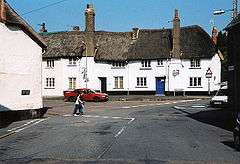Silverton, Devon
Silverton is a large village and civil parish, about 8 miles (13 km) north of Exeter, in the English county of Devon. It is one of the oldest villages in Devon and dates from the first years of the Saxon occupation.[1]
| Silverton | |
|---|---|
 Fore Street, Silverton | |
 Silverton Location within Devon | |
| Population | 1,494 (2011 Census) |
| OS grid reference | SS955028 |
| Civil parish |
|
| District | |
| Shire county | |
| Region | |
| Country | England |
| Sovereign state | United Kingdom |
| Post town | EXETER |
| Postcode district | EX5 |
| Dialling code | 01392 |
| Police | Devon and Cornwall |
| Fire | Devon and Somerset |
| Ambulance | South Western |
| UK Parliament | |
It has been suggested[2][3] that the medieval manor of Burn, within the modern parish of Silverton, may be the estate listed as Mylenburnan (Mill-on-the-Burn or Burn Mill) in the will of King Alfred the Great of 899, now in the British Library, in which it was left to his youngest son Athelweard (c. 880-922).
In the year 2001, its population was 1,905, recounted to 1,494 at the United Kingdom Census 2011.[4] The electoral ward with the same name had a population of 1,875 at the above census.[5] The parish has three pubs: The Lamb, The Ruffwell Inn, and The Silverton Inn. The church, dating back to the fourteenth century, is dedicated to St Mary. It has a full set of bells that are rung regularly. Inside, the pews have doors at the end of each row which is unusual in this area. The village also has a further two churches - an Evangelical and a Methodist church; both are popular with social and youth clubs.
The village is on the "old" road from Exeter to Tiverton and as such was once a busy thriving place. Now it has become a dormitory for people working in Exeter although there are still a number of original families living in the village. A post office, a small supermarket (Spar), butcher's shop and a hairdresser offer most necessities for the residents.
The main feature of the village is the giant oak tree which is over 1,000 years old.[6]
The Bristol and Exeter Railway opened Silverton railway station in 1867 but it has since closed.
On the first Saturday of each August, the village holds a Street Market, which is popular among local people. There are stalls selling local goods and crafts, as well as entertainment and children's activities organised throughout the day, and the tug-of-war always ends the day on a high.
Silverton is represented on Mid Devon District Council by Liberal Democratic Party Councillor Josh Wright (Village Ward) and by Independent Councillor Bob Deed (North Ward).
Silverton North Ward
Silverton Parish is divided into two wards; Village Ward to the south includes the village of Silverton together with the hamlets of Ellerhayes, Greenslinch, Hayne and Poundsland, and is home to around 95% of the population of the parish. In contrast, North Ward with a population of around 80, is almost entirely rural. Noted Devon historian William Hoskins claimed that Silverton North Ward was the location of Stochelie, a Domesday manor whose location had long been lost. If correct, North Ward would at one time have contained a small manor quite separate from Silverton. Until the 1990s the only settlements comprised a dozen or so working farms. Today most of these have been converted into small groups of dwellings including Underleigh, Dorweek, Ravenshayes and Leigh Barton. Bounded to the west by the small Burn river and to the north by the village of Butterleigh and lying on the slopes of the Hayridge Hills, North Ward affords tranquillity as well as stunning views of the Exe, Burn and Culm valleys.[7]
Silverton Parochial Trust
The Silverton Parochial Trust is a historic charity still operating in the Silverton area. It comprises a collection of 13 legacies, the earliest dating from 1616 and now formed into a modern charitable trust controlling property, land and investments. It is managed by seven resident trustees. Funds are available for the immediate assistance of parishioners who are in a condition of ‘need, hardship or distress’ which is not provided for by the state schemes such as Social Services or state benefit programmes.
Parish church

The parish church, dedicated to St Mary, is a building mainly of the 15th and 16th centuries; it has a nave, chancel and north and south aisles. The west tower has battlements, buttresses and four pinnacles. The north aisle was built with funds left by a rector who died in 1479; a rebus referring to a rector of 1519-49 is on the east respond of the north arcade. A new chancel, vestry and two western bays were added by the architects Hayward and Ashworth in 1860-63.[8]
Twin city

See also
- Silverton Park, a demolished large mansion
References
- "Silverton". Devon County Council. Retrieved 9 July 2016.
- Keynes, Simon, and Lapidge Michael, trans. Alfred the Great: Asser’s Life of King Alfred and Other Contemporary Sources. Harmondsworth, UK: Penguin, 1983, p. 175
- Hooke, Della, Pre-Conquest Charter-Bounds of Devon and Cornwall, Boydell Press, 1994, p. 104, ISBN 978-0851153544
- "Parish population". Retrieved 22 February 2015. Note: The 2001 figure is for the whole civil parish whereas the 2011 figure is for the village only.
- "Ward population 2011". Retrieved 22 February 2015.
- "Silverton a village with character tucked away in the past". Pinns. Retrieved 9 July 2016.
- Silverton Parish Council
- Pevsner, N. (1952) South Devon. Harmondsworth: Penguin; p. 263